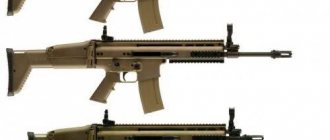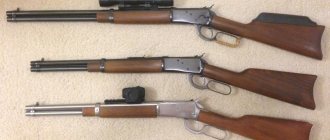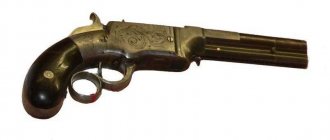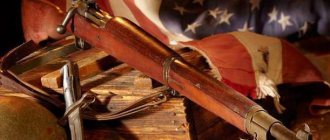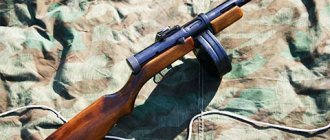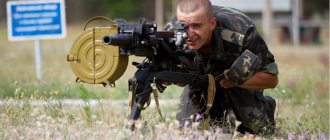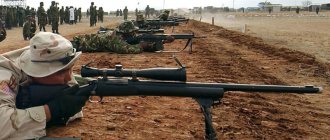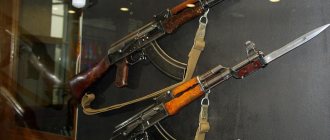Henry rifles with a bracket (Lever Action in English) have gained incredible popularity, only in terms of total circulation they are slightly behind the well-known Kalashnikov. It is noteworthy that, despite its popularity, barrels of this type were never officially in service anywhere, although they survived many military stories. This probably happened because for that time the concept of a pistol cartridge in a weapon with a long barrel turned out to be too innovative, as was the rifle mechanism.
The story is similar for the Mauser S-96, a legendary pistol that was used from the Boer War almost until the present day, and was also not officially in service anywhere, although in Russia and Germany it was recommended to officers for independent acquisition.
Where it all began
Among the first pistols that marked an end to the history of the Wild West was the Vulcanic. A pistol of this type is very interesting in itself - it is the first rifle with a lever-brace and an under-barrel tubular magazine. Reloading was carried out using a lever similar to the Henry staple, but designed for one finger. Today in gun stores you can come across replicas (copies) of the “Vulcanic” chambered for a unitary cartridge. They are deservedly popular among fans of Wild West weapons.
How Winchester 1887 works
The principle of operation of the Winchester is similar to the operation of similar smoothbore shotguns equipped with a Henry bracket.
In order to load the gun, you need to move the Henry brace in the direction of the muzzle. Ammunition is inserted into the opened magazine. Next, the bracket returns to its original position, simultaneously cocking the hammer, as well as chambering the cartridge from the feeder into the chamber. The lever system rises up and is in line. From below, the entire system is supported by the Henry bracket itself. At this time, the bolt is fixed at the breech of the barrel, and the next cartridge is pushed out of the magazine into the feeder.
After pressing the trigger, the hammer strikes the bolt piston, which in turn strikes the primer. A shot is fired.
It is worth noting that fully charging the magazine can take quite a lot of time. But manufacturers have provided the possibility of accelerated charging. The essence of this method is to independently place one cartridge in the chamber and the other on the feed tray. After closing the staple, two shots can be fired immediately.
The cartridge from the magazine does not jump out onto the feed tray until the shooter squeezes the trigger. The trigger is open, with a safety cock. The shotgun can be safely stored with a cartridge in the chamber. The Model 1887 shotgun is fed with cartridges from an under-barrel tubular magazine.
An open trigger allows you to carry a weapon with a cartridge inside the chamber without fear of spontaneous firing. You just need to manually cock this trigger.
The total length of the weapon is 997 mm, barrel length is 508 or 813 mm, weight is 3.6 kg, magazine capacity is 5 rounds. This weapon became a milestone in the development of multi-shot repeating smoothbore shotguns.
History and characteristics of the 1860 Henry rifle
The Winchester 70 is one of the first lever-action rifles, which received its baptism of fire on June 25, 1876, during the battle between the Indians and the American army. This collision occurred in Montana near the Little Big Horn.
It was an attempt by soldiers of the Seventh Cavalry under the leadership of Lieutenant Colonel J. Custer to clean up the Sioux tribe. However, the enterprising natives expected such a turn of events and managed to prepare well. They gathered all their forces, purchased Henry Winchester rifles, new at that time, and a fair amount of ammunition for them. If we remember the fact that the Indians were mainly sold only weapons that had lost their relevance - capstan or flintlock, then this time the thirst for profit among the sellers overcame all common sense, and people from the Sioux tribe received brand new multi-shot rifles of 38 and 44 calibers. Unheard of carelessness of gun store owners! After all, this weapon was distinguished by an unimaginable rate of fire at that time of 50-60 rounds per minute and a magazine of 10-12 rounds, depending on the length of the barrel and the caliber of the rifle.
The army was armed with high-quality and reliable 45-caliber Springfields and Spencers, accurate, powerful, but with one charge. The rate of fire in them strongly depended on the location of the cartridge belt rather than on the hinged bolt. It was high when mounted on a rifle, but gradually decreased when the shooter switched to a belt belt, falling completely while removing cartridges from pockets and other secluded storage areas. The Henry rifle had only one drawback - a rather weak revolver cartridge. But this could be compensated for by sharply reducing the distance to the enemy, which was used in practice.
Why is a .410 caliber shotgun called a “garbine carbine” in the USA?
The 410 caliber (0.41 inches according to the inch system, 10.4 mm according to the metric system) is the youngest of the smoothbore calibers. According to the classification accepted in Russia, this caliber is between 36 and 37, i.e. 36 spherical bullets of this caliber can be cast from one English pound of lead. Any reference book says that Winchester began producing cartridges of this caliber in 1934. This is not entirely true. Short shot cartridges for .41 caliber pistols have existed before. Such pistols were called “snake” pistols; they say farmers used them to shoot snakes. A pistol is more convenient than a shotgun; you can always carry it with you, but a poisonous snake can be found anywhere, for example, in a car. Because of one snake, you won’t spoil your car with a bullet that will pierce through it and, God forbid, ruin any mechanism. Well, hitting a nimble snake with a bullet is also problematic. But with very fine soft shot the result is completely different. There are a lot of pellets in the cartridge, it does not penetrate metal, and it is quite easy to shoot towards the target. At least one pellet will hit. During the Great Depression, a 0.41-inch caliber rifle cartridge with a length of 70 mm (the same one that is written about in reference books) was released by Winchester as a cheaper replacement for the expensive .365 caliber rifled cartridge for shooting competitions. Because depression is depression, and the people demand, in addition to bread, circuses. The 410 caliber cartridge was almost 4 times cheaper than the .365, and weapons for it, due to the lack of a rifled barrel, were also inexpensive.
Further, guns chambered for this cartridge began to be positioned as “universal for owners of large estates,” because the range of a bullet with a 410 barrel is much further than classic smoothbore ones, and from a rifled carbine you cannot shoot with shot, for example, at a flock of ducks. A small-caliber smoothbore gun successfully combines the advantages of both a smooth barrel (shot shot) and a rifled barrel (shooting a bullet at long distances).
In Russia, guns of this caliber began to be produced en masse in the 90s of the 20th century. The most popular “device” of this caliber in Russia is the Saiga 410, which is discussed below.
What is it intended for? Small game hunting, self-defense, recreational shooting (plinking). Moreover, for the latter, “hunting” for cans, bottles, bricks and paper targets, a light, accurate, low, comfortable recoil 410 caliber weapon is most suitable.
Advantages:
Low, very comfortable recoil. You practically don't feel it. Consequently, the 410 can be painlessly (without quotes, in the literal sense of the word) used for long shoots. This caliber is also good for women and children. In the West, small-caliber self-defense guns are called “home guns.”
It’s not for nothing that a 410 caliber shotgun is called a “quasi-carbine.” In a narrow barrel, the pressure (all other things being equal) is much higher, therefore, the flight range of the bullet (buckshot and shot, too, but to a lesser extent) is much greater than the “classic” hunting calibers (12, 16, 20). When using the Paradox attachment, which spins the bullet, this weapon is generally uncompetitive with any of the larger caliber guns. In addition, a narrow bullet is less affected by rain, wind and other interfering factors, therefore, the target is hit more accurately, especially at a long distance.
In Russia, you don’t have to wait 5 years for a license for a rifle.
There are fewer wounded animals left on the hunt, since the amount of shot in the cartridge is 2-2.5 times less than in classic hunting rifles, and its speed is much higher and it flies further.
All other things being equal, 410 caliber weapons are much lighter than classic ones.
Saiga 410, the most common 410 caliber “device” in Russia, is very similar to the Kalashnikov assault rifle. Saiga 410K-2 is generally made from a combat AK-74. That is, a good show off. Cool! The smoothbore analogue of the American M-16 rifle is generally produced only under the 410th cartridge.
Relatively cheap ammunition if you make it yourself. This is not prohibited by law.
Flaws:
Expensive ammunition. Also a feature of Russia. The cost of production is lower than the 12th, and the cost is sometimes twice as much! And you can’t buy a good, imported cartridge everywhere. The manufacturing quality of Russian cartridges is also very unstable, “one bangs, one pops, but it’s from the same pack” - a phrase from one of the weapons forums. There is only one way out: to ensure uniform characteristics, you have to “twist the cartridges” yourself. But there is also a difficulty here; the equipment for self-equipment is also a big problem.
As stated above, a .410 shotgun should be lighter than other shotgun calibers. However, this does not apply to Russia; we always follow our own, incomprehensible path. Thus, 410 hunting rifles (except Saiga-410) are made on heavy 12-gauge blocks, which are almost twice the diameter of 410. You can’t understand Russia with your mind...
Weak stopping effect of a light bullet traveling at high speed at self-defense distances (close range or point-blank range). In this case, it is better to use large shot or buckshot. True, recently they began to produce 410-caliber cartridges with a special self-defense expansive bullet, which, when it hits the target, flattens and does not pierce right through.
Well, now the answer to the question asked in the title. A 410 caliber shotgun is ideal for “hunting” starlings pecking at cherries in the garden, as well as large animals, such as foxes or gilts, that have climbed into the garden. And at long ranges, only the 410 caliber can compete with a rifled carbine.
Lever-action rifles debut
J. Custer made a reconnaissance and found that there were more Indians than expected, however, he arrogantly decided to carry out the attack. Without waiting for reinforcements, he divided the detachment in half and attacked the Sioux settlement from two sides. The first part was ambushed (if you remember that the Indians had a three or even four times superiority in the rate of fire during close combat, everything falls into place), suffered losses and retreated, but the Indians, not allowing them to break the distance, overtook and completely defeated the squad. The second detachment, not expecting such powerful resistance, immediately dispersed. Another detachment, coming to their aid, completely changed its trajectory when it heard the cannonade standing over the camp.
It was a delightful debut for Henry rifles in the form of the Winchester 70. Of course, it did little to help the Sioux settlement historically, but it definitely made people think about the use of repeating weapons.
Next, you can observe how gloriously the Henry rifles fought in the First World War in the hands of soldiers of the Russian army. An order was placed in the United States for several tens of thousands of such rifles chambered for 7.62x54. But, as it turned out, the contract was not fully fulfilled, their quantity was insufficient, so later they turned into genuine antique firearms that adorned any collection.
Winchester 1887 shotgun
Home | Weapons | Smoothbore weapons | USA | Winchester 1887/1901
Winchester 1887 shotgun
The Winchester Model 1887 is the first truly successful Henry-bucket shotgun. It was this reloading scheme that Browning chose for this weapon at the request of the Winchester Repeating Arms Company, known for its popular Winchester 1873 rifle. The creator of the 1887 model, the famous American weapons designer John Moses Browning, proposed a reloading scheme with a longitudinally sliding forend, which is much more suitable for multi-shot smoothbore shotguns. However, Winchester, then known as the manufacturer of Henry Brace rifles, felt that their new shotgun should have a similar reloading system for brand recognition reasons.
Browning developed a suitable design, although Winchester later produced a Browning bolt-forend shotgun known as the Model 1893. Browning's Winchester 1887 shotgun, loaded with a Henry clamp, fired 12-gauge black powder cartridges. The window for loading and ejecting the cartridge case is located at the top of the receiver. This gun has a relatively small swing action. Protection against an accidental shot when the bolt is unlocked is very simple - there is a small protrusion on the back of the trigger that rests against the bracket when the bolt is unlocked.
The cartridge from the magazine does not jump out onto the feed tray until the shooter squeezes the trigger. The trigger is open, with a safety cock. The shotgun can be safely stored with a cartridge in the chamber. The Model 1887 shotgun is fed with cartridges from an under-barrel tubular magazine. The total length of the weapon is 997 mm, barrel length is 508 or 813 mm, weight is 3.6 kg, magazine capacity is 5 rounds. This weapon became a milestone in the development of multi-shot repeating smoothbore shotguns. The Winchester 1887 shotgun was supplied to the civilian market, as well as to police and railroad companies.
However, this model did not become as popular as previous Winchester rifles. Soon it was decided to remake the 1887 model so that it could use cartridges filled with smokeless powder. This is how the Winchester Model 1901 shotgun appeared, but it was produced only in 10 gauge. The Model 1901 was never offered in 12 gauge because Winchester did not want to compete with their successful "pump-action" Model 1897. The Winchester Model 1901 features a two-piece lever and a Winchester emblem on the top of the weapon, behind the trigger. Serial numbers go from 64856 to 79455.
Despite Browning's successful design, the market for Henry-brace shotguns declined significantly, as John Browning foresaw, after the introduction of the Winchester 1897 and other so-called pump-action shotguns with a longitudinally sliding fore-end. Winchester Model 1887 shotguns produced 64,855 units between 1887 and 1901. Between 1901 and 1920, another 14,600 Winchester Model 1901 shotguns were produced before the Henry Bracket Winchester shotgun was discontinued.
Smoothbore weapons
- India
- South Korea
- South Africa
- USA
- Russia
- Türkiye
- Belgium
- Ukraine
- Italy
- Philippines
Kings of the hunt
However, no one can deny the fact that the main niche of Henry rifles is hunting. Lever weapons on the American continent were an indispensable attribute of travelers and hunters. It was even called the “cowboy weapon” in the Wild West. Since there are no protruding parts on the rifle (bolt handles, magazine, etc.), it can be easily and quickly stored in an oblong case that resembles a knife sheath, and placed in a car, on a horse, attached to a backpack. This weapon is lightweight and always ready to fire. Loading it is very simple: if the cartridge is in the chamber, just cock the hammer, but if not, just one movement of the clamp and you're done!
The first rifles earned their popularity thanks to the successful choice of cartridge. For hunting any game in North America, the revolver analogue was just right; with it you could easily go even to a bison. Moreover, it turned out that it was incredibly convenient to have a rifle and a revolver chambered for a unitary cartridge. The long and happy life of the lever-action rifle, the brainchild of American designer Benjamin Henry, is due to its simple and reliable mechanism, tolerance of poor conditions and unpretentiousness.
Having talked about the history of rifles, we can move on to a more detailed acquaintance with weapons with a Henry brace.
Henry brace and Colt forend
1. Winchester-Henry carbine model 1866 with a long under-barrel magazine;
the trigger guard is folded back. 2. Model 1886 Winchester-Henry carbine with a short under-barrel magazine. 3. Winchester-Henry system carbine, model 1895, with a stack magazine. 4. Colt carbine, model 1883. 5. Colt carbine, model 1887. The American Winchester rifle was one of the first weapon systems chambered for a metal cartridge. It was designed, however, not by Winchester at all, but by the American gunsmith and engineer B. T. Henry for a special metal side-fire cartridge of 44 caliber (11.2 mm). In 1860, he assigned the patent and all rights to this gun to O. F. Winchester. Henry himself became the director of the Winchester factory, and these weapons began to be named after the owner of the company; from 1867 and the factory became known as “Winchester Repiting Arms Super”.
In 1895, a special army model of Winchester was created by order of the Russian government under a three-line Russian cartridge. The rifle had a middle magazine for 5 rounds and was also reloaded with a trigger guard-lever. For a long time it was used by fishermen of Siberia and the Far East as a hunting rifle.
Systems with a tubular under-barrel magazine also include a gun from the American Colt arms factory in Hartford. Its design was developed by W. Elliott in 1883. Two years later, the company began producing hunting and sporting carbines of this system in 44 caliber with both regular and shortened barrels. A special feature of this system was reloading with a special lever driven by a forend sliding along the under-barrel magazine. Moving the movable forend back and forth ensured, through a system of levers and hinges, ejection of the cartridge case, feeding of the cartridge, cocking the hammer and locking the chamber. It was carried out with the left hand, which could simultaneously support the gun, and thus the gun could not be removed from the shoulder. In 1887, a similar carbine of 22 caliber (5.6 mm) was patented for short and long cartridges, with a magazine capacity of 16 and 15 rounds, respectively. Until 1903, 90 thousand of these carbines were manufactured. From 1885 to 1895, Colt's factory produced a similar Express magazine system in various calibers and sizes. This was the company's last hunting and sporting rifle.
Currently, in the United States, various companies produce several models of hunting rifles - both with a Henry bracket and with a Colt movable forend. In our country, guns of such systems are not produced.
Yu. Shokarev Hunting and game management 11-1980
WINCHESTER-1886
This is an original Winchester that was produced by the company between 1886 and 1892. It has a powerful faceted barrel designed to accept unjacketed lead bullets and black powder. The model is quite old, so it is not surprising that the inscription WINCHESTER, once stamped on the metal, may be worn out from long-term use. Despite the fact that this model is more than 120 years old, all the mechanisms work properly, and the mock-up of the cartridge is thrown out and sent back without any delays! Antique gun enthusiasts are scratching their heads over the clue to the .44 WCF mark.
It is clear that the first letter is the name of the manufacturer (Winchester), but the next two raise doubts about the interpretation. There is an assumption that CF is center fire, that is, central fire. During the creation of the rifle, an active transition from ring-fire cartridges to cartridges with a primer in the center of the case bottom had just begun. They were called center fire. A little later, these letters disappeared, and the cartridge that fits this rifle began to be called 44-40. Indirectly, the letters WCF say that it is better to shoot only cartridges with black powder. The carbine box is open at the top; there is a window on the right for charging, which is closed by a spring-loaded door. The box itself is durable and quite massive, made of a single piece of metal.
General description of the Winchester 1887 shotgun
The Winchester m1887 was a smoothbore weapon equipped with an under-barrel tubular magazine, an exposed hammer, and a Henry brace as the loading mechanism.
Winchester stood out for its unusual appearance. The Henry brace gave it a certain sophistication that many gun aficionados still enjoy today. The weapon looks especially impressive with a bent bracket. This is how people remember him.
The Winchester 1887 model was used by both civilians and police. Railroad and postal services also created additional demand.
Increased security made it possible to store and transport the shotgun even fully equipped with cartridges. There will be no accidental shots, and in case of danger, the weapon is very quickly prepared to fire.
The design of the gun, as well as the use of 12-gauge black powder cartridges, were not to everyone’s taste. The window for loading and ejecting the cartridge case is located at the top of the receiver. This gun has a relatively small swing action. Protection against an accidental shot when the bolt is unlocked is very simple - there is a small protrusion on the back of the trigger that rests against the bracket when the bolt is unlocked.
The use of black powder cartridges prompted manufacturers to modernize the hard drive. The Winchester 1901 was created, which differed from its predecessor by using smokeless powder cartridges and reducing the caliber. This model used 10 gauge. No further significant differences were observed. The Winchester 1901 shotgun has become more widespread, which is associated primarily with the unusual caliber of the weapon.
Other characteristics
The layout of the store is interesting. It does not have any cartridge interceptors; they are held by the feed tray. This is a very reliable and simple design, the only feature of which is the fact that the cartridge must strictly correspond to a certain length so that the feed mechanism does not jam. The shutter of the “cowboy weapon” is classic - reliable and durable locking with two wedges in the rear. The wedges are controlled by the reloading lever; they move down and unlock the bolt during reloading. Then it moves back due to the movement of the bracket forward through a system of levers. Then the hammer is cocked, which removes the cartridge case and lifts the feed tray with the cartridge. When the reloading lever moves back, the cartridge from the tray is sent into the barrel. Next, when raised, the wedges lock the bolt, the tray is lowered, the magazine opens, in turn, the cartridge from it enters the tray.
Design Features
The Winchester m1887 shotgun had a relatively small receiver, which increased the convenience of the design. For shooting, 12 gauge cartridges with black powder were used. Loading and ejection of the cartridge case was carried out through the upper part of the receiver, with a special hole for these purposes. The small size of the shutter also did not interfere with operation. The empty cartridge case was not only thrown up, but also twisted.
Winchester 1887 was distinguished by increased security. An unlocked bolt, through a special bracket, prohibited the full range of movement of the trigger. The trigger also had some features. On the back there was a small protrusion that rested against this very bracket. Thus, the possibility of an accidental shot was completely neutralized.
Sales of these guns were hit by the appearance of a large number of models with a longitudinally sliding loading principle. The strongest competitor was the trench Winchester M1897, which became the market leader in pump-action shotguns.
Shutter mirror
It is also original. Its entire lower part is moved forward and spring-loaded. It carries two functions. The first is the reflector. During the movement of the bolt back, the constantly spring-loaded sleeve is, as it were, wedged between the chamber and the lower part of the cylinder. As the case leaves the chamber, the deflector, upon release, ejects the case from the case. The advantages here are undeniable: despite the slow opening of the shutter, extraction will always be reliable. The second function is to prevent a shot from being fired when the shutter is not closed. The firing pin simply will not be able to reach the primer while part of the bolt is moved forward. The thoughtfulness and simplicity of the design is simply amazing; it is worth noting that it is the result of a huge amount of work on milling and fitting complex parts. Attention to them can be seen in the following touch: the aiming line is blocked by the released trigger, signaling that you are about to shoot, but the gun is not ready to fire.
Advantages and disadvantages of Winchester Model 1887
First, let's look at the advantages of this gun:
- Original and ergonomic design, very attractive to many.
- Reliable design that does not fail when shooting.
- Convenient shape and dimensions.
- Easy to operate and use.
- Popular 12 gauge.
There are also disadvantages:
- The magazine cannot be reloaded while in use.
- Use of black powder cartridges.
- Some parts are rare.
- The cost is high.
MARLIN MOD-1895
This is a very powerful and high-quality rifle in 45-70 caliber. Its dimensions are not much larger than the previous model, but it is quite heavy. The cartridge is powerful, accelerating a 21-gram bullet to 500 m/s. We can safely recommend it for hunting in Russian forests.
Up to a distance of 150 m, it has a flat trajectory, and during zeroing at 100 m, corrections from 0 to 150 m can be neglected. The Marlin box is closed, it has two windows on the right side. The bottom one is for charging and has a door. The upper one is used to extract the cartridge case. The reflector is located in it, and when reloading it is better to vigorously retract the bolt to ensure reliable ejection of the cartridge case. To lock the bolt there is one wedge entering from the bottom. During closing, it supports a part that transmits the blow from the hammer to the firing pin, which ensures that it is impossible to fire with the bolt open. The gun itself is solid, maneuverable and powerful, as experts say. It is considered an excellent option for driven hunts for large and medium-sized animals.
ROSSI carbines with Henry shackle - time-tested weapons
"Master Gun" magazine, August 2013
Weapons reloaded with a Henry clip (collectively referred to as “Winchester”) are a rare phenomenon in modern Russia. Mainly due to the high cost of ammunition, which was not produced in our country. With the expansion of the range of hunting weapons in Russia, there has simultaneously been a move away from conversion weapons. Increasingly, hunters choose weapons and ammunition not from what is simpler and cheaper, but based on their own needs. For example, some types of hunting require a powerful cartridge with high stopping power. Until recently, this role was performed either by shotgun cartridges or large-caliber rifle cartridges. In both cases, weapons for such ammunition are either light, but single-shot, or multi-shot, but heavy.
Since November 2011, multi-charged weapons for pistol and, especially, revolver cartridges have become available in Russia. Revolving cartridges have a wide range of calibers and an equally wide range of power - after all, weapons for them are not entirely automatic and are not demanding on the amount of gunpowder and bullet weight. Hunting with long-barreled weapons and revolver cartridges is popular in a number of countries on the two American continents. In the long barrel of carbines and rifles, the revolver cartridge fully develops its potential and is quite capable of hitting various game at distances of up to 150-200 meters.
As you know, every game needs its own cartridge. That's why Henry's ROSSI 92 repeating rifles are offered in a wide range of calibers. The most common two-caliber option is .38 Special / .357 Magnum. The first has a muzzle energy of up to 300 J, while the second can develop up to 1000 J. Those who like a higher stopping power of a bullet are offered the ROSSI 92 chambered for the 19th century .45 Colt cartridge. With up to 700 J of energy and a power factor of 190, this subsonic ammunition combines high stopping power with moderate recoil. At the top of the line is the ROSSI 92 in .454 Casull. A .454 bullet weighing from 14 to 20 g can develop energy up to 3200 J, and being semi-sheathed or expansive it allows you to hunt large and dangerous animals. Moreover, the weight of ROSSI 92 carbines ranges from 2.1 to 2.6 kg, depending on the type of barrel (round or octagonal) and its length (16, 20 or 24 inches). This was achieved due to the lack of automation.
It is worth noting that reloading with a Henry staple is still considered the fastest of the non-automatic systems. The permanent under-barrel magazine has a capacity of 8-10 rounds. The open trigger allows you to visually monitor the condition of the trigger. ROSSI 92 are made from alloy blued or stainless steel. There are modifications with a brass receiver. ROSSI 92 carbines are purchased under a license for hunting rifles. However, admirers of smoothbore carbines with a Henry brace have not been forgotten either - for them ROSSI produces the RIO GRANDE model in caliber .410*65.
Sincerely,
chief technical consultant
ROSSI-92
It is a pretty good copy of Winchester 92, which was produced by the Brazilian company Puma. To comply with modern standards, a safety lever was added, mounted on the bolt, which also locks the firing pin. The firing pin is fully blocked, although it remains possible to reload, cock the hammer, and even release it without firing. The second improvement is the key that locks the trigger. It just turns, and that’s it - the rifle is completely blocked, it is impossible to cock the trigger or open the bolt.
This feature is considered very convenient. And another useful innovation is a coiled mainspring instead of the plate spring that was on the original. It is much more durable and simpler.
Description
The Winchester m1887 was a smoothbore weapon equipped with an under-barrel tubular magazine, an exposed hammer, and a Henry brace as the loading mechanism.
Winchester stood out for its unusual appearance. Henry's brace gave him a certain sophistication that still haunts many to this day. The weapon looks especially impressive with a bent bracket. This is how people remember him.
The Winchester was used by both civilians and police. Railway services also created additional demand.
Increased security made it possible to store and transport a hard drive even fully equipped with cartridges. There will be no accidental shots, and in case of danger, the weapon is very quickly prepared to fire.
The design of the gun, as well as the use of black powder cartridges, were not to everyone’s taste. This prompted manufacturers to modernize the hard drive. The Winchester 1901 was created, which differed from its predecessor by using smokeless powder cartridges and increasing the caliber. This model used 10 gauge. No further significant differences were observed. Winchester 1901 has become more widespread, which is associated primarily with the unusual caliber of the weapon.
Winchester 1887 by Chiappa
HENRY GB
This rifle is from the company that gave its name to the entire line. Many fans of such weapons say with sadness that only 22-caliber weapons are supplied to Russia. Those who have purchased a good quality model note its appearance: yellow box, expensive quality wood, octagonal heavy trunk. The rifle has a classic look and box shape, reminiscent of a Winchester 70. Collectors note the smooth operation of the mechanisms. The shutter movement is so smooth and soft that it feels like it is rolling on rollers.
The rifle box is closed, there is one window on the left for cartridge case extraction. There is a special hole on the magazine for charging. You need to turn the washer and pull the spring tube out of the magazine body, then insert the tube and spring back until it stops. That's it, the weapon is loaded - you can shoot. This type of charging is very convenient for those who prefer recreational shooting.
Hunting rifles caliber 12×70 gas operated, pump action and Henry brace
Every hunter knows that the choice of weapon is paramount in this matter. First of all, it is necessary to determine the required technical characteristics and features of various manufacturers and types of weapons, on which the final cost will depend. How to Buy a 12×70 Gas, Pump, and Henry Brace Hunting Rifle
it is necessary with all responsibility, carefully selecting the right model.
The most common among hunters are smooth-bore rifles, which do not have a long firing range like rifled carbines, but have other advantages. To purchase them, you only need a weapons permit; you can use ammunition such as shot, buckshot or bullet. Rifled carbines allow you to hunt large animals due to the possibility of using large-caliber cartridges; they can also be used to conduct targeted shooting over long distances.
Smoothbore guns can be divided into several types:
- single-barreled (single-shot and multi-shot models, with the possibility of manual or automatic reloading);
- double-barreled (models with horizontal and vertical barrels).
Hunting weapon
can be classified as follows:
- smoothbore - the first stage for every hunter, with their help you can shoot at a target at a short and medium distance;
- rifled - will be needed for long-distance shooting and for hunting large animals;
- combined - combines all the advantages of the above types of weapons, since it can be used with various ammunition.
Before purchasing a hunting weapon, you should carefully study the features of each of the types presented above, pay attention to their features, capabilities and characteristics, and only after that make your final choice. It is also worth noting that to begin with, in any case, you need to purchase a smoothbore gun, and after 5 years of owning it, you will be able to obtain a license for a rifled carbine.
To select the most suitable model of hunting weapon, you can use a filter by parameters such as series, model, caliber and operating principle. After choosing, you will be able to order a hunting rifle caliber 12×70 gas operated, pump action and Henry bracket
in the World of Hunting online store.
The product is sold only in accordance with the established requirements of Federal Law No. 150 of December 13, 1996. “On Weapons”, as well as other requirements of the legislation of the Russian Federation.
conclusions
A common disadvantage of such rifles is disassembly. To carry out this operation, you must have a whole set of slotted screwdrivers available. The passport of the Rossi rifle generally says that if disassembly is necessary, you should contact a gunsmith. This cannot but amaze our people, who are ready to open anything without an additional tool. In general, such weapons are an excellent historical rarity; such rifles can also serve as companion rifles, for example, at a shooting range. Still, this is an antique and a pleasant thing to look at, and not a means of murder.
The Lever Action is not very suitable for hunting; hunters would rather prefer a semi-automatic or bolt-action rifle. But the Henry rifle would happily go on a trip. But who will decide to take such a rare item with them on a risky enterprise is another question.

